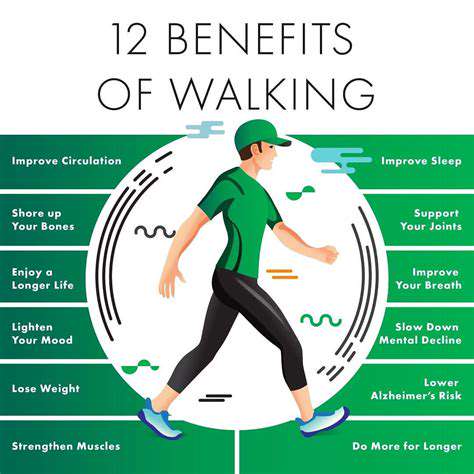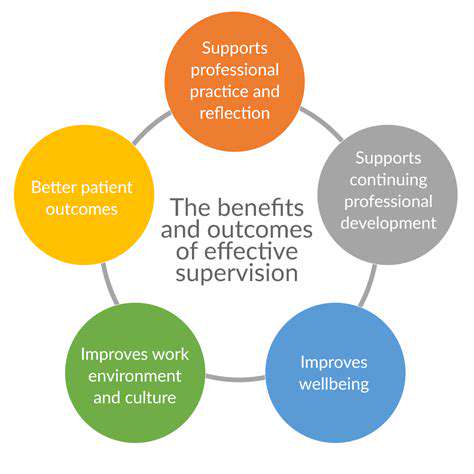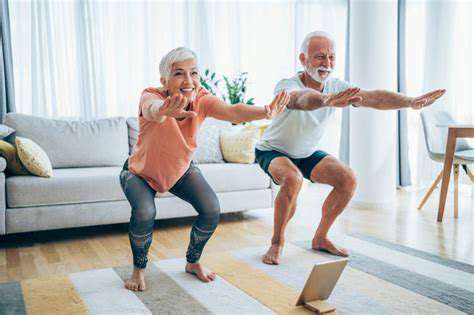Strength Training for Seniors to Improve Sleep Quality
The Link Between Strength Training and Senior Sleep
Strength Training's Impact on Sleep Quality
Many older adults overlook strength training, yet it's one of the most effective ways to enhance sleep quality. Research consistently demonstrates that physical activity improves sleep patterns, but not all exercise is created equal. The gradual progression of resistance in strength training helps recalibrate the body's internal clock, making it easier to fall asleep and stay asleep. This methodical approach to exercise teaches the body to handle physical stress more efficiently, resulting in deeper, more restorative sleep.
Beyond just initiating sleep, resistance exercise extends its benefits throughout the night. Participants often report sleeping longer with fewer interruptions. The natural endorphins released during weight-bearing activities create a sense of relaxation that lingers long after the workout ends. For older individuals struggling with sleep maintenance, incorporating moderate strength training two to three times weekly can transform nighttime rest without requiring extreme physical exertion.
Building a Stronger Body, a More Restful Night
Resistance training offers seniors far more than muscular development - it builds physical resilience that directly translates to better sleep. Age-related muscle loss (sarcopenia) frequently causes discomfort that disrupts sleep. By systematically rebuilding muscle tissue, older adults can regain the physical comfort needed for uninterrupted sleep. The controlled fatigue from proper strength workouts creates ideal conditions for falling asleep naturally and staying asleep through the night.
The psychological benefits are equally important. Regular strength training sessions provide measurable reductions in stress hormones while boosting mood-regulating neurotransmitters. This dual physical-mental benefit makes resistance exercise uniquely effective for addressing the root causes of sleep disturbances in older populations. When combined with proper sleep hygiene, a well-designed strength program can significantly improve both sleep quality and overall quality of life for seniors.
This discussion highlights the sleep-enhancing potential of consistent strength training for older adults. As with any new fitness regimen, consultation with a physician is recommended, particularly for those managing chronic health conditions.
How Strength Training Improves Sleep in Seniors
Boosting Metabolism and Energy Levels
While muscle building is the most visible effect, strength training's metabolic impact profoundly influences sleep. The natural metabolic slowdown that accompanies aging often leads to energy fluctuations and weight management challenges. Resistance exercise counteracts this decline by preserving and increasing lean muscle mass, which elevates baseline calorie burning. This metabolic boost creates more stable energy patterns throughout the day, setting the stage for better sleep at night. The improved glucose metabolism from regular strength training also helps regulate circadian rhythms.
Reducing Stress and Anxiety
Older adults frequently experience sleep disruption from stress and worry. Strength training serves as a powerful antidote to these psychological barriers. The focused physical effort stimulates production of endorphins and other neurochemicals that naturally alleviate tension. The mental concentration required during proper lifting technique creates a meditative effect, quieting racing thoughts that often interfere with sleep onset. Many seniors report that post-workout relaxation lasts well into the evening, making it easier to transition into restful sleep.
Strengthening Bones and Muscles for Better Support
Musculoskeletal health directly impacts sleep quality in older populations. Resistance training simultaneously builds bone density and muscular strength, addressing two common sources of nighttime discomfort. Enhanced muscular support reduces joint pain that might otherwise cause frequent awakenings, while improved posture from stronger core muscles allows for more comfortable sleeping positions. These combined effects create the physical foundation for continuous, high-quality sleep.
Improving Circulation and Blood Flow
Optimal circulation plays a crucial role in sleep regulation. Strength training enhances vascular function, delivering more oxygen and nutrients throughout the body. This improved circulation helps normalize body temperature - a critical factor in sleep maintenance. Better blood flow to the brain during waking hours also promotes more efficient transition into sleep, while supporting the neurological processes that govern deep sleep cycles.
Managing Chronic Pain Conditions
Arthritis and other chronic pain conditions disproportionately affect older adults' sleep. Properly supervised strength training can significantly reduce these symptoms. By strengthening the muscles around affected joints, resistance exercise creates natural stabilization that diminishes pain. This pain reduction frequently translates to longer, less interrupted sleep. The anti-inflammatory effects of regular strength training provide additional benefits for those with arthritis-related sleep disturbances.
Enhancing Sleep Hygiene and Routine
Strength training contributes to better sleep by reinforcing healthy daily rhythms. The discipline of regular workouts helps regulate the body's internal clock, while the physical exertion creates appropriate fatigue at day's end. This natural tiredness differs from exhaustion - it's the satisfying fatigue that promotes quicker sleep onset and more restorative sleep cycles. Many seniors find that combining strength training with other sleep hygiene practices creates powerful synergy for better rest.
Promoting Hormonal Balance
Hormonal changes significantly impact sleep as we age. Resistance training helps modulate these changes by supporting endocrine system function. The physical stimulus of strength exercise promotes more balanced production of sleep-related hormones like melatonin and cortisol. This hormonal regulation leads to more consistent sleep-wake patterns, helping seniors maintain healthier circadian rhythms despite age-related changes.
Tailoring Strength Training for Seniors
Understanding the Benefits of Strength Training for Seniors
While often associated with younger athletes, resistance training provides unique advantages for older adults. Beyond building muscle, it enhances stability to prevent falls, increases bone mineral density to combat osteoporosis, and maintains functional strength for daily activities. These physical improvements directly translate to greater independence and life satisfaction, allowing seniors to remain active in their communities and hobbies.
The psychological benefits are equally valuable. Achieving strength milestones fosters confidence and self-efficacy, countering age-related stereotypes. This mental empowerment often improves overall outlook and sleep quality simultaneously, creating a positive cycle of physical and mental well-being.
Adapting Exercises for Different Fitness Levels
Effective senior strength programs must accommodate varying abilities. Successful modifications might include seated versions of exercises, reduced range of motion, or alternative equipment like resistance bands. The key is maintaining proper form while adjusting intensity to individual capabilities. Even small strength gains can yield significant functional improvements and sleep benefits for previously sedentary seniors.
Prioritizing Safety and Precautions
Safety considerations take priority when designing senior strength programs. Medical clearance is essential, particularly for those with cardiovascular or orthopedic conditions. A proper warm-up and cool-down period becomes increasingly important with age, helping prevent injury while preparing the body for exercise and recovery. Listening to the body's signals and allowing adequate recovery between sessions ensures sustainable progress.
Choosing the Right Equipment and Techniques
Equipment selection should prioritize safety and accessibility. Many seniors benefit from machines that support proper form, progressing to free weights as ability increases. Bodyweight exercises often provide the most adaptable foundation, requiring minimal equipment while allowing infinite scalability. Regardless of equipment, emphasis on controlled movements and full-range motions maximizes benefits while minimizing injury risk.
Incorporating Cardio and Flexibility into the Routine
A comprehensive senior fitness program balances strength, cardiovascular, and flexibility training. Low-impact cardio like swimming or cycling complements resistance training without excessive joint stress. Regular stretching maintains the mobility gains from strength work, preventing the stiffness that can interfere with comfortable sleep positions. This integrated approach addresses all components of physical fitness that influence sleep quality.
Creating a Sustainable and Enjoyable Routine
Long-term adherence depends on making exercise enjoyable and rewarding. Starting with modest, achievable goals builds confidence and habit. Social components like group classes or workout partners significantly improve consistency. Many seniors find greater motivation when they connect exercise to specific life goals - whether playing with grandchildren or maintaining independent living. These personal connections make the sleep benefits more tangible and meaningful.











